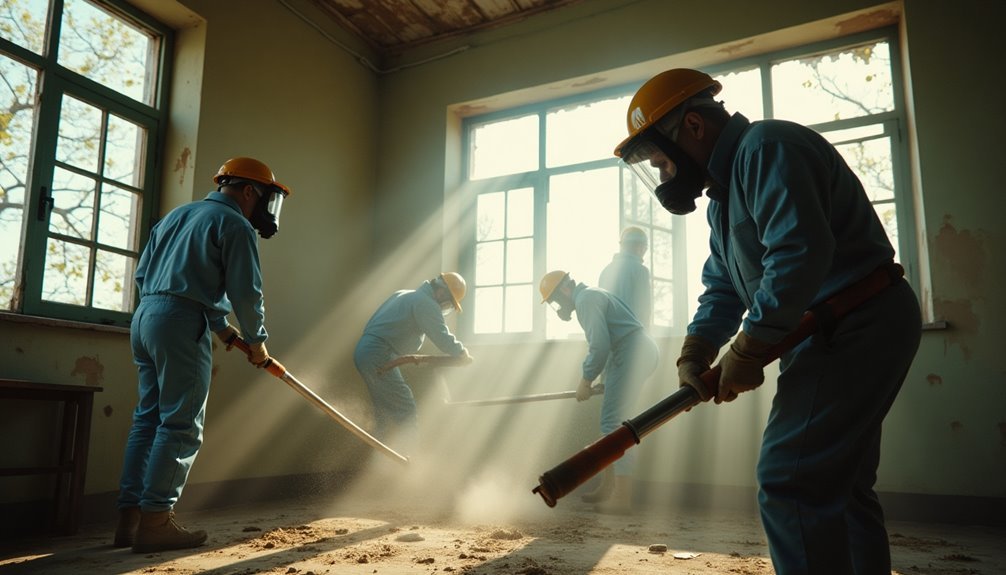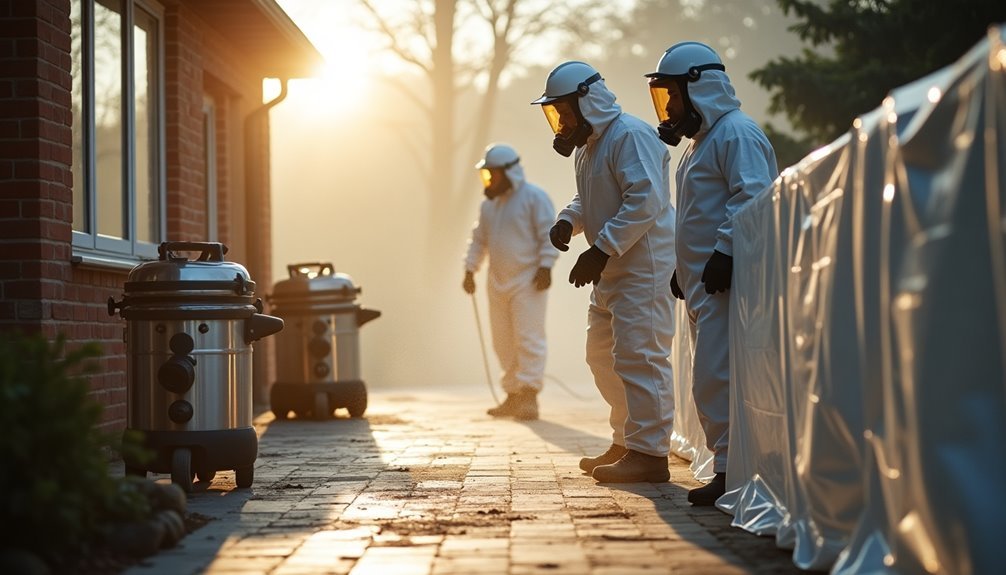Professional asbestos abatement services protect your property by eliminating health hazards associated with asbestos exposure. They ensure compliance with OSHA and EPA regulations, minimizing your risk of hefty fines and legal issues. Certified experts conduct thorough inspections, implement safety protocols, and use specialized equipment to safely remove or encapsulate asbestos materials. This proactive approach not only enhances your property's market value but also makes it more appealing to potential buyers. By addressing asbestos risks, you're securing a healthier environment and reducing future liabilities. You'll find insights on how these services can further benefit your property as you explore more.
Health and Safety Benefits

Asbestos abatement services significantly enhance the health and safety of both occupants and workers by effectively reducing the risk of asbestos-related diseases, such as lung cancer, mesothelioma, and asbestosis. By eliminating or containing asbestos-containing materials, you're directly addressing health risks associated with exposure. Comprehensive risk assessments and safety planning ensure safer living and working environments.
To maintain rigorous safety standards, meticulous preparation and planning are essential. This includes securing necessary permits and notifying authorities, which protects health during the abatement process. If needed, temporary relocation of occupants guarantees complete safety.
Personal protective equipment (PPE) plays a vital role in safeguarding workers. Wearing properly sealed hooded suits, steel-toed boots, and respirators with HEPA filters prevents fiber exposure. Safety protocols, including sealing off work areas and employing negative air pressure systems, minimize the escape of harmful fibers. Additionally, the abatement process must involve certified professionals to ensure compliance with local regulations.
Moreover, workers undergo rigorous training to comply with federal and state regulations, ensuring they handle asbestos safely. Regular health monitoring and a detailed abatement plan reinforce safety measures. By prioritizing health and safety, you're not just complying with standards; you're actively protecting lives.
Financial and Legal Advantages
Investing in professional asbestos abatement services offers substantial financial and legal advantages that can significantly impact your property. By ensuring compliance with asbestos regulations, you'll avoid costly fines and legal liabilities. Professionals effectively manage disposal fees, which can range from $10 to $50 per cubic yard, optimizing labor costs that typically range from $75 to $200 per crew member. Additionally, the removal costs—between $5 to $20 per square foot for interiors and $50 to $150 for exteriors—can be better managed through professional planning. Opting for encapsulation can lead to cost savings of 15-25% compared to complete removal. Enhancing your property's value and marketability is another financial benefit; asbestos-free properties attract buyers and tenants, leading to higher rental or sale prices. Moreover, professional abatement services provide legal protections, ensuring that you meet all necessary regulations. Hiring certified contractors not only ensures safety but also minimizes health risks associated with improper handling. By seeking multiple quotes, you can compare costs while ensuring quality. With proper planning and budgeting, you can manage inspection and disposal fees effectively. Ultimately, these factors combine to create a financially sound approach while safeguarding your legal interests.
Regulatory Compliance

Ensuring your property is free from asbestos not only boosts its value but also involves navigating a complex regulatory landscape. From federal to local regulations, compliance challenges can be daunting. Here's what you need to consider:
- Federal Oversight: OSHA and EPA set strict training and job site protection standards for asbestos abatement.
- State Licensing: State governments issue licenses and permits, ensuring that only qualified professionals handle asbestos.
- Local Regulations: Cities and counties may have additional requirements, including their own notification processes.
- Notification Requirements: You must notify state agencies at least 10 days before significant renovation or demolition involving asbestos-containing materials (ACM).
Staying updated on regulatory updates is crucial for maintaining compliance. Federal regulations like NESHAP and AHERA impose specific obligations, while local rules may introduce additional layers of complexity.
Asbestos Abatement Process
When tackling an asbestos abatement project, understanding the process is crucial to ensuring safety and compliance. The first step involves inspection and assessment, where professionals use various asbestos testing methods to identify potential asbestos-containing materials. They collect samples for laboratory analysis to confirm the presence and type of asbestos, assessing the associated risks to develop a preliminary abatement plan.
Next, containment and air filtration techniques are implemented. The work area is sealed with impermeable barriers, and air filtration devices are installed to create negative air pressure. HEPA filters ensure that any air exhausted is free from asbestos fibers, maintaining an airtight environment.
During removal and handling, the abatement techniques focus on minimizing airborne fibers. Asbestos-containing materials are wetted to reduce dust, and hand tools are used for careful removal. HEPA-filter vacuums capture microscopic particles, while debris is double-bagged in clearly labeled hazardous material bags.
Finally, decontamination and disposal procedures are conducted. The area is thoroughly cleaned, air quality tests ensure safety, and asbestos waste is disposed of in licensed landfills, following strict regulations to guarantee a safe environment for occupancy.
Specialized Techniques and Equipment

Specialized techniques and equipment play a vital role in the effective management of asbestos abatement projects. By employing advanced asbestos identification techniques and containment strategies, professionals can ensure a safer environment. Here are four critical components:
- Removal: Complete extraction of damaged asbestos materials using specialized tools and wet methods to minimize dust generation.
- Encapsulation: Sealing intact asbestos materials with sealants to prevent fiber release, ideal for materials in good condition.
- Enclosure: Constructing barriers around asbestos to isolate it, which requires careful planning to ensure effective containment.
- Selective Techniques: Choosing the best method based on the asbestos's condition, location, and potential exposure risk, ensuring compliance with regulatory requirements.
The use of specialized equipment, such as HEPA vacuums, air scrubbers, and protective gear, further enhances safety during abatement. HEPA vacuums effectively capture asbestos particles, while air scrubbers purify the air. Protective clothing ensures workers are shielded from exposure. Each technique and tool is essential for preventing the spread of asbestos fibers and creating a secure environment for both workers and occupants.
Worker Protection Measures
Worker protection measures are crucial in asbestos abatement to safeguard both personnel and building occupants from harmful exposure. To begin with, comprehensive worker training is essential. Each worker must undergo rigorous training and certification to handle asbestos safely, which includes understanding the associated risks and proper procedures. This training also covers the selection, use, and maintenance of protective equipment, ensuring that every worker knows how to use respirators and personal protective equipment (PPE) effectively.
When it comes to protective equipment, you must ensure that all workers are equipped with respirators that fit properly and meet manufacturer specifications. Additionally, full-body coveralls, head coverings, and impervious shoe coverings should be worn to prevent asbestos fiber penetration. Regular inspection, cleaning, and maintenance of this equipment are necessary to maintain its effectiveness.
Work area safety protocols should be strictly followed. Mark hazard areas clearly, limit access to authorized personnel, and minimize activities in areas with damaged asbestos materials. Decontamination procedures, including the use of HEPA-filtered vacuums and proper disposal of contaminated clothing, are vital to ensure worker safety. By implementing these measures, you protect not just your workers, but also the occupants of your property.
Long-Term Property Value

As you consider the long-term value of your property, removing asbestos significantly enhances its market appeal and compliance with health regulations. By ensuring your home is asbestos-free, you reduce future liabilities associated with health risks and potential legal issues. This proactive approach not only boosts property value but also positions your investment as safer and more attractive to potential buyers.
Enhanced Market Appeal
When considering property investments, addressing asbestos concerns plays a crucial role in enhancing market appeal and long-term value. By prioritizing asbestos abatement, you can significantly boost your property's desirability in a competitive market. Here are four key benefits:
- Increased Property Value: Abated properties can command higher prices, eliminating the deterrent asbestos poses to buyers.
- Reduced Negotiation Leverage for Buyers: By removing asbestos, you take away a bargaining chip that buyers often exploit to negotiate lower prices.
- Improved Marketability: An asbestos-free property attracts a broader range of buyers, enhancing its appeal through documented safety assurances.
- Long-Term Financial Benefits: Investing in asbestos abatement reduces future maintenance costs and legal liabilities, ensuring higher resale values.
As you stay informed about asbestos awareness and current market trends, remember that properties free of asbestos not only attract more buyers but also command better prices. In today's real estate landscape, addressing asbestos proactively isn't just a choice; it's a smart investment strategy that pays off in the long run.
Compliance With Regulations
While navigating the complexities of property ownership, compliance with asbestos regulations is crucial for maintaining long-term value. Ignoring these regulations can lead to significant compliance challenges, including hefty fines and potential legal repercussions. When you sell a property, you're legally obligated to disclose the presence of asbestos, and failure to do so can result in lawsuits.
Staying updated on regulatory updates is essential for avoiding costly penalties. Obtaining the necessary permits for abatement and notifying relevant authorities ensures that you adhere to legal requirements and that the abatement process is conducted safely and effectively. Proper documentation throughout this process further secures your compliance.
A comprehensive risk assessment is vital in determining the necessity of abatement, evaluating the condition of asbestos-containing materials, and planning appropriate response strategies. By actively engaging in these compliance measures, you not only enhance your property's safety standards but also protect its market value. Compliance with asbestos regulations ultimately reduces the risk of future liabilities, allowing you to enjoy the financial benefits of a well-maintained property without the burden of non-compliance.
Reduced Future Liabilities
Addressing asbestos issues proactively not only safeguards your property but also significantly reduces future liabilities, enhancing its long-term value. By investing in professional abatement services, you're engaging in effective liability management and risk mitigation that pays off in numerous ways:
- Reduced Property Devaluation: Properties with asbestos can lose 5-15% of their value. Removing it preserves your investment.
- Lower Insurance Premiums: Asbestos presence often leads to higher insurance costs. Removal normalizes rates, saving you money long-term.
- Enhanced Marketability: Asbestos-free properties attract more buyers, boosting your chances for quicker sales and better offers.
- Avoidance of Future Removal Costs: Proactively addressing asbestos prevents you from incurring substantial discounts or removal costs later, which can range from $1,192 to $6,000 or more.
Conclusion
In the battle against asbestos, professional abatement services act as your shield, safeguarding your property and health. By ensuring regulatory compliance and leveraging specialized techniques, you not only protect your investment but also enhance its long-term value. Choosing experts means you're not just addressing a hazard; you're securing peace of mind for yourself and future occupants. Don't leave your property vulnerable—invest in professional services and watch your safety and property value flourish like a well-tended garden.
